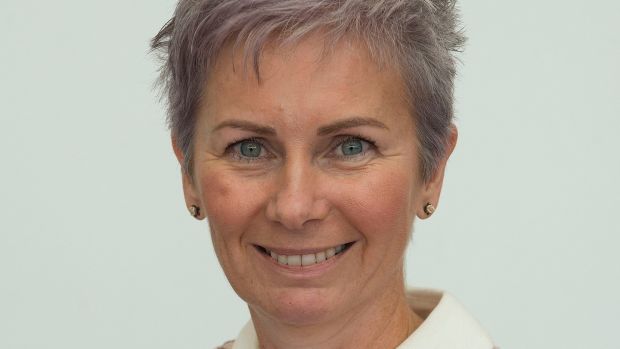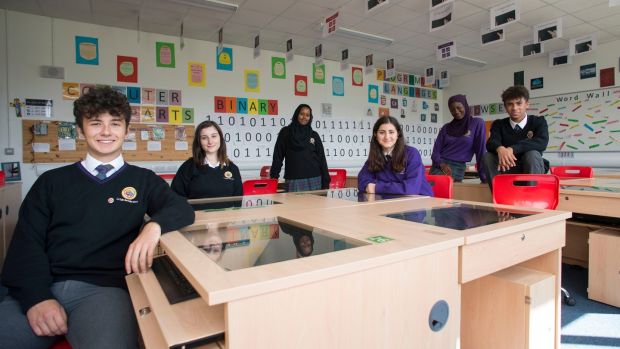
With 67 nationalities, is this Ireland’s most diverse school?

Le Chéile in Tyrrelstown has 67 different nationalities among its student body. What are the challenges and opportunities posed by such diversity in a school?
Irish Times Sat, Aug 25, 2018
It was Friday, November 13th, 2015, the night of a co-ordinated terrorist attack in Paris. Le Chéile Secondary School inTyrrelstown, northwest Dublin, had been open for just over a year and, despite its Catholic ethos, students had enrolled from all different nationalities and religions.
From the start, Le Chéile had embraced innovative ways of learning, getting rid of textbooks and creating its own learning resources on iPads. Using a platform called Schoology, the students could share lessons, communicate with their teachers and talk to each other. But that weekend, the principal, Dr Áine Moran, looked on in concern as racial and religious tensions threatened to flare up online.
One of the students went on the school’s platform and mentioned a report that Syrian and Egyptian passports had been found and that they belonged to the attackers (it later transpired that the Egyptian passport belonged to a victim while the Syrian passport may have been forged or planted). Another student jumped in to counter this and, as can happen online, an argument about race and religion threatened to spill over into real life.

“We hadn’t seen this kind of spat before,” says Moran. “We only had first and second years in the school at this stage and we weren’t immediately sure what to do. We decided we would intervene if we needed to. But, very quickly, one of our Muslim students helped dissolve any tensions.
“She suggested that we should all pray together and offered to organise a non-denominational prayer and reflection service for everyone, focused on bringing people together where they were increasingly divided elsewhere.
“The students themselves organised the service, placing the Bible, Torah, Qu’ran, and mandalas [from Hinduism and Buddhism] in the centre of our non-denominational prayer room. We also did some colouring as a reflective and calming exercise.”
The potential flashpoint dissipated and since then the school has consciously worked to promote harmony and diversity.
New community
Tyrrelstown is a relatively new community on the border of Meath, with an almost ever-present hum from aeroplanes coming to and from Dublin airport. A planned town that began to grow in the early part of the last decade, it’s close to Blanchardstown and the more socially deprived areas of Corduff and Mulhuddart.
According to the 2016 census, over 40 per cent of its population were born outside the State. At primary level, the area is served by two Educate Together national schools, a Catholic school and a Gaelscoil. Socially, the local population comes from both professional and working class backgrounds, with major local employers including Connolly Hospital and IT firms such as IBM.

“We were among the first schools where the parents were allowed to choose the patron,” says Moran. “This is one of the most pluralist parts of pluralist Dublin in an increasingly pluralist Ireland. Everybody expected that they would opt for a non-denominational secondary. It was a big surprise when they chose a Catholic school.”
Last May, Taoiseach Leo Varadkar, who represents the constituency, formally opened the only secondary school in Tyrrelstown, which had taken in its first students back in 2014. He arrived at what is likely, with at least 67 different nationalities from all corners of the globe, Ireland’s most diverse school. Many of the young people here have either arrived directly from their country of birth, or they are the first generation of their family to be born in Ireland. A small number of them have grown up in direct provision and five students are unaccompanied minors who fled war or poverty and arrived in Ireland alone.
It is a highly populated and very diverse community, which can be both a positive and a negative
A new community such as Tyrrelstown offers a chance to build a special place, or to make the same mistakes that blighted poorly planned communities such as Ballymun. “It is a highly populated and very diverse community, which can be both a positive and a negative,” says Michaela Solinas (17), a student at Le Chéile who sits on the council of Foróige, a national youth group. “The problem is that most people don’t know their neighbours.”
According to Stephen Balaneasa (17), whose family are originally from Romania, “There can be a tendency for different ethnic groups to not interact.”
But, says Niamh O’Connor (15), there’s less division in school. “Once you get to know your classmates, what you see is their personality, and there’s way less splitting up into groups – as well as less fights.”
Anti-social behaviour
In recent years, the media has reported on some anti-social behaviour carried out by teenagers of all ethnicities in Tyrrelstown, especially males. But, say the students, the problems in Tyrrelstown are relatively minor and often overblown.
“Yes, there is some anti-social behaviour in the community but also a lot of work being done to counter it,” says Jessica Odemena (15), who has an Irish mother and Nigerian father. “I’ve had friends standing at a tree being chased away and accused of anti-social behaviour.”
The young people resent how their astroturf pitch was taken from them. “The boys, in particular, used that pitch,” says O’Connor. “When it was removed, they played on greens outside houses and the neighbours were annoyed and said that they were hitting their windows, but it was accidental.”
The students say their school genuinely listens and responds to them and that this has led to more sports options for girls and a general feeling that their views will be taken on board. However, it’s a different story outside the school gates, and the council and local politicians must be willing to engage with and truly listen to their voices, says Solinas.
Moran, who previously worked at a disadvantaged school in Tallaght, says services including public transport can be too slow to come to newer areas and that the council can be neglectful when it comes to maintaining the area. But, she says, a vocal and active number of residents are emerging as community leaders and have improved communication between the residents and also ensured that facilities such as community centres are established.
The challenge of diversity is not trying to make everyone the same, but genuinely embracing difference
“We set high expectations for the students and their behaviour,” says Moran. “This applies inside the school gate and outside, especially when wearing the uniform. That uniform brings a very diverse student body together on the same journey. The challenge of diversity is not trying to make everyone the same, but genuinely embracing difference,” says Moran.
“Our motto is welcome, wisdom, witness and, to be a truly Catholic school, means welcoming all, regardless of their nationality, gender, sexuality or religion [the school is one of many Catholic schools which marks BeLonGTo’s Stand Up week against homophobic and transphobic bullying and, Moran says when asked, has openly LGBT staff members].”
Once a week, Catholic mass is held at the beginning or end of the school day and no student is obliged to attend, says Moran. Muslim students are supported during Ramadan and the school provides religious education but not religious instruction.
“All faiths and none attend the school, although there is a non-denominational secondary school 2km away if parents prefer. There is nothing in our core Catholic values that cannot also speak to humanist value systems. We have a code of behaviour built on core beliefs which include the celebration of difference, and everyone at the school is both a teacher and a learner. We educate young people to develop and follow their own conscience.”
How diversity is an educational strength
How do you teach a classroom where the students have such different needs? Some have learning difficulties, some have poor English language skills and some are excelling academically. Children from the Philippines, India, Vietnam, Brazil, Peru, Hungary, Poland, Ireland and elsewhere, often with different religious backgrounds, bring very difficult cultural experiences and expectations to the classroom.
Many of the children are bilingual, although they are asked not to speak in their home language during everyday school interactions.
“This is our strength,” says Le Chéile’s principal, Áine Moran. “We all learn from our experiences and from hearing of other people’s experiences.”

Early on, cognitive tests found that the students all had different learning styles, and Moran was keen to make sure that every student was taught in a way that really spoke to them. “The way to do this was to create our own learning resources. When we began, the teachers were generating the material, but now much of it comes from the students themselves. Films, animations, speech, drama, podcasts and mind maps are just some of the ways we learn here. This diversity in methods and people means that the classes speak to all students.”
Group work is common at the school and the classrooms have been designed with this in mind.
“We’re all teachers and learners here and if you make a good keynote, it can easily be shared with the rest of the class,” says student Jessica Odemana.
“Using the iPads doesn’t feel like learning,” says student Niamh O’Connor. “You do group work with friends and can learn in the way that suits you best.”
Workshops
The Leaving Cert Applied is being introduced this year. Every Monday morning, school opens with an hour of “blue sky” module, where students can choose between 20 different workshops to focus on their own project, including Young Scientist, hair and beauty, radio or coding. The school has embraced “flipped learning”, whereby teachers record the lesson and make it available to the students at home, with class time dedicated to helping students gain a deep understanding of the material. “We’ve seen the students outperform expectations as a result,” says Moran.
Moran says the diversity in the classroom now needs to be met by a more diverse teaching profession so that migrant students can see role models. “Recently, a trainee teacher who arrived in Ireland from Cameroon in her third year of secondary school was on placement at Le Chéile and she helped us understand cultural differences, but it was also very positive for the students to see someone who came the same route as themselves and is now about to become a teacher. We look forward to our former students returning to be teachers here.”

